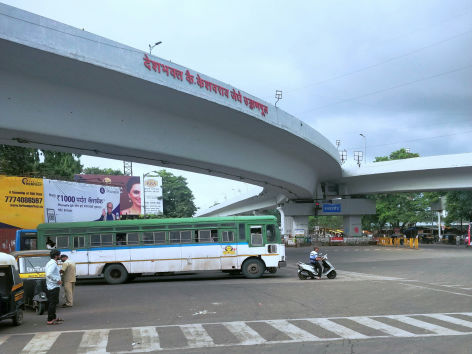City Logistics Plans: Guidelines to making India’s urban freight smart and efficient

India's urban population is projected to rise from 35% to 50% by 2050, adding approximately 416 million new urban dwellers.1 This unprecedented growth surges demand for goods and services, driving the urban freight sector to expand at a compound annual growth rate (CAGR) of 8-10%, fuelled by e-commerce, retail, and manufacturing.2 However, city logistics3, accounting for 60-70% of last-mile delivery costs, remain a persistent challenge, often addressed through fragmented and ad-hoc planning.4
Challenges in Urban Freight Management in India
Traditionally, urban logistics in India have been perceived as a problem rather than an integral part of urban planning. As with Sustainable Urban Mobility Plans (SUMPs), Comprehensive Mobility Plans (CMPs)5 often only put minimal emphasis on urban logistics, primarily addressing passenger transport. Moreover, as urban freight movement is largely managed by private entities, Indian public authority’s ability to manage these is limited. A lack of strategic development and governance competence has resulted in the emergence of several issues linked to freight:
- Competing Road Space: Freight and passenger vehicles share the same transport network in India, leading to congestion and inefficiencies.
- Congestion and inefficiency: Estimations suggest that freight vehicles contribute significantly to congestion in major Indian metropolitan areas such as Delhi, Mumbai, and Bengaluru, accounting for 30-40% of road traffic.6 The average vehicular speed in these cities has dropped to 15-20 km/h, reducing productivity and increasing fuel consumption. Inefficient routing and improper planning further exacerbate delivery delays and elevate logistics costs.
- Environmental and economic implications: Urban freight transport contributes to 25-30% of transport-related CO₂ emissions in Indian cities, with trucks and delivery vehicles making up 40% of transport-related air pollution.7 Additionally, unregulated and fragmented supply chains lead to higher logistics costs – an estimated 14% of the GDP compared to the global average of 8-10%.8 These inefficiencies result in an estimated economic loss of $45 billion annually.
Need for a CLP (City Logistics Plan) in India
A well-designed CLP for Indian cities can notably mitigate congestion, reduce logistics costs, lower emissions, and enhance last-mile connectivity. By implementing smart logistics solutions, such as better coordination and digital innovations, delivery times can be reduced by 20-30%. Government initiatives such as the National Logistics Policy (NLP) 2022 and PM Gati Shakti National Master Plan (NMP) are already fostering improvements in this domain.
The adoption of Logistics 4.0, which integrates smart policies, green logistics, and digital technologies, will be pivotal in building a sustainable urban freight ecosystem. Measures such as deploying electric vehicles (EVs), utilising cleaner fuels, and optimising delivery routes can drastically cut emissions and operational costs.
Policy Framework and Implementation
In November 2024, the Indian Department for Promotion of Industry and Internal Trade (DPIIT), in collaboration with the Indo-German technical cooperation under GIZ’s Green Freight Project, finalised model CLPs for Delhi and Bengaluru. The initiatives were followed by the formulation of Guidelines for Preparing City Logistics Plan for Indian Cities, aimed at enabling states and cities to design efficient and sustainable urban freight systems.
The guidelines provide a structured framework for cities to develop localised logistics solutions by:
- Defining a clear vision and objectives tailored to each city's unique characteristics.
- Collecting and analysing data to map freight distribution networks.
- Implementing suitable infrastructure and policy interventions in collaboration through freight quality partnerships (FQPs).
Moving Towards a Sustainable Future
The CLP guidelines publication serves as a dynamic, evolving document that incorporates feedback from stakeholders and policymakers. By fostering a structured approach to city logistics, these efforts align with India's broader agenda of Ease of Doing Business (EoDB) and its long-term commitment to achieving Net Zero emissions by 2070. With strong policy backing and collaborative efforts, India is poised to revolutionise its city logistics landscape, ensuring a more sustainable and efficient future for its growing cities.
1 United Nations Department of Economic and Social Affairs (UN DESA)
2 Mordor Intelligence
3 City logistics refers to the efficient and sustainable movement of goods within urban areas.
4 OneRail
6 Urban Emissions
7 International Energy Agency
8 The National Council of Applied Economic Research (NCAER)